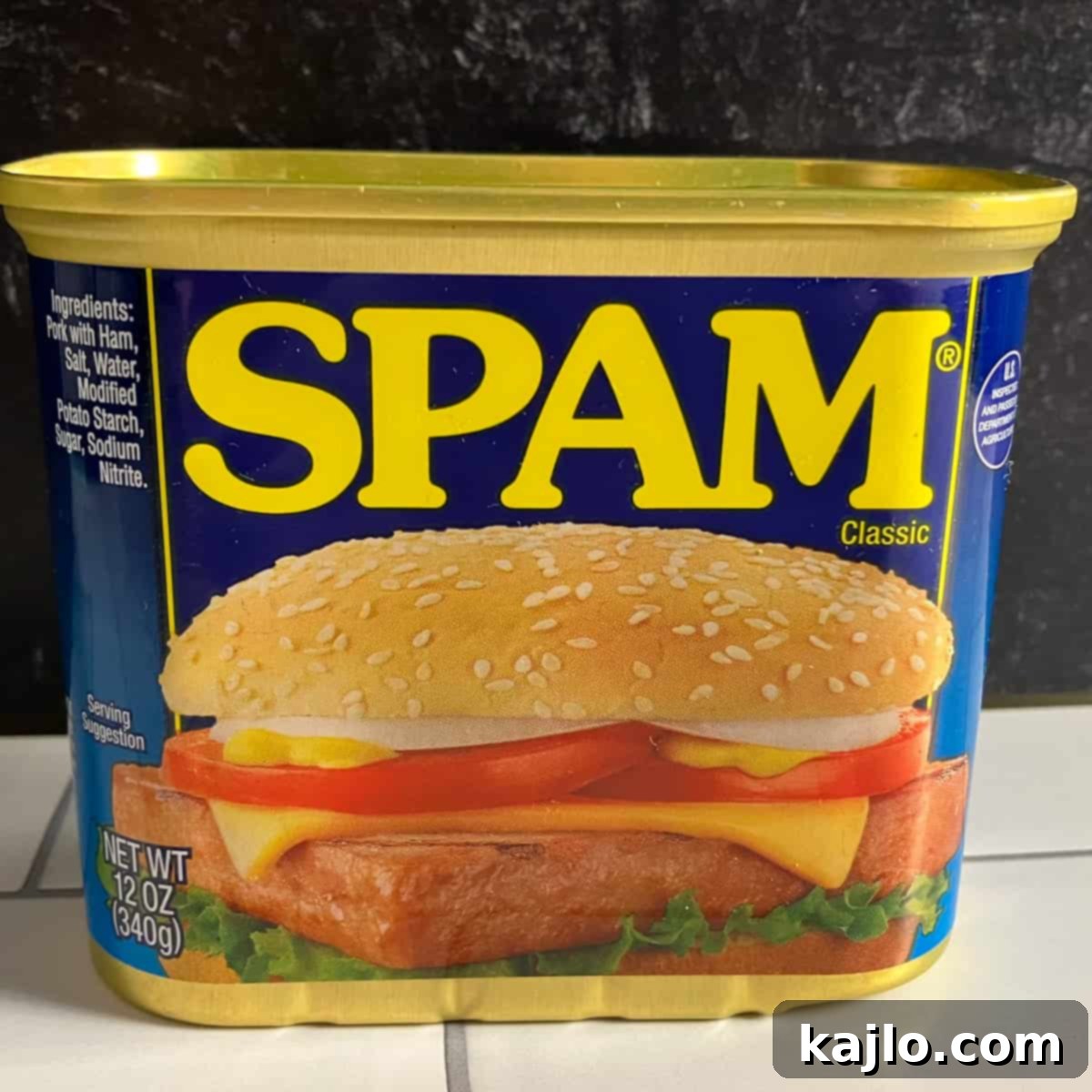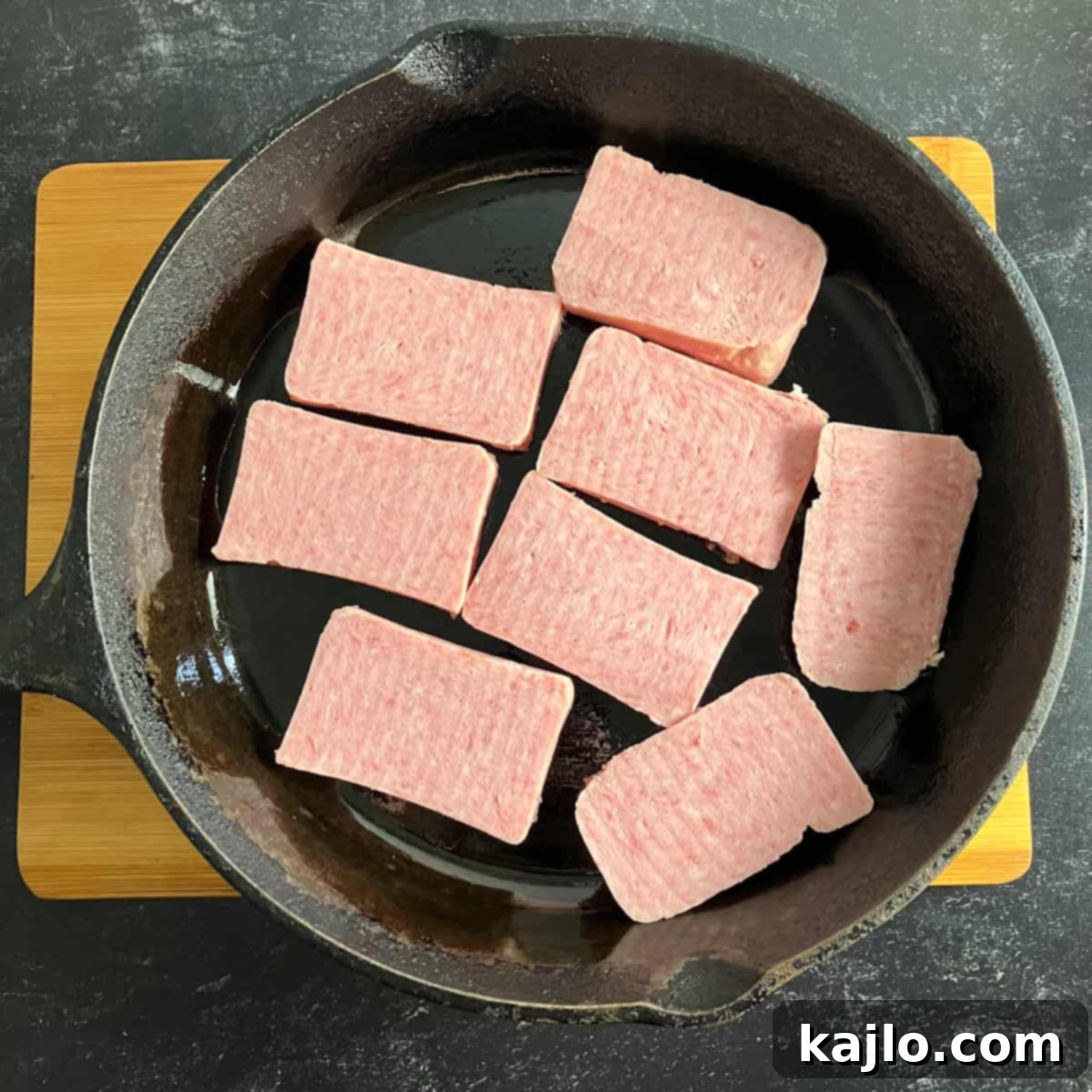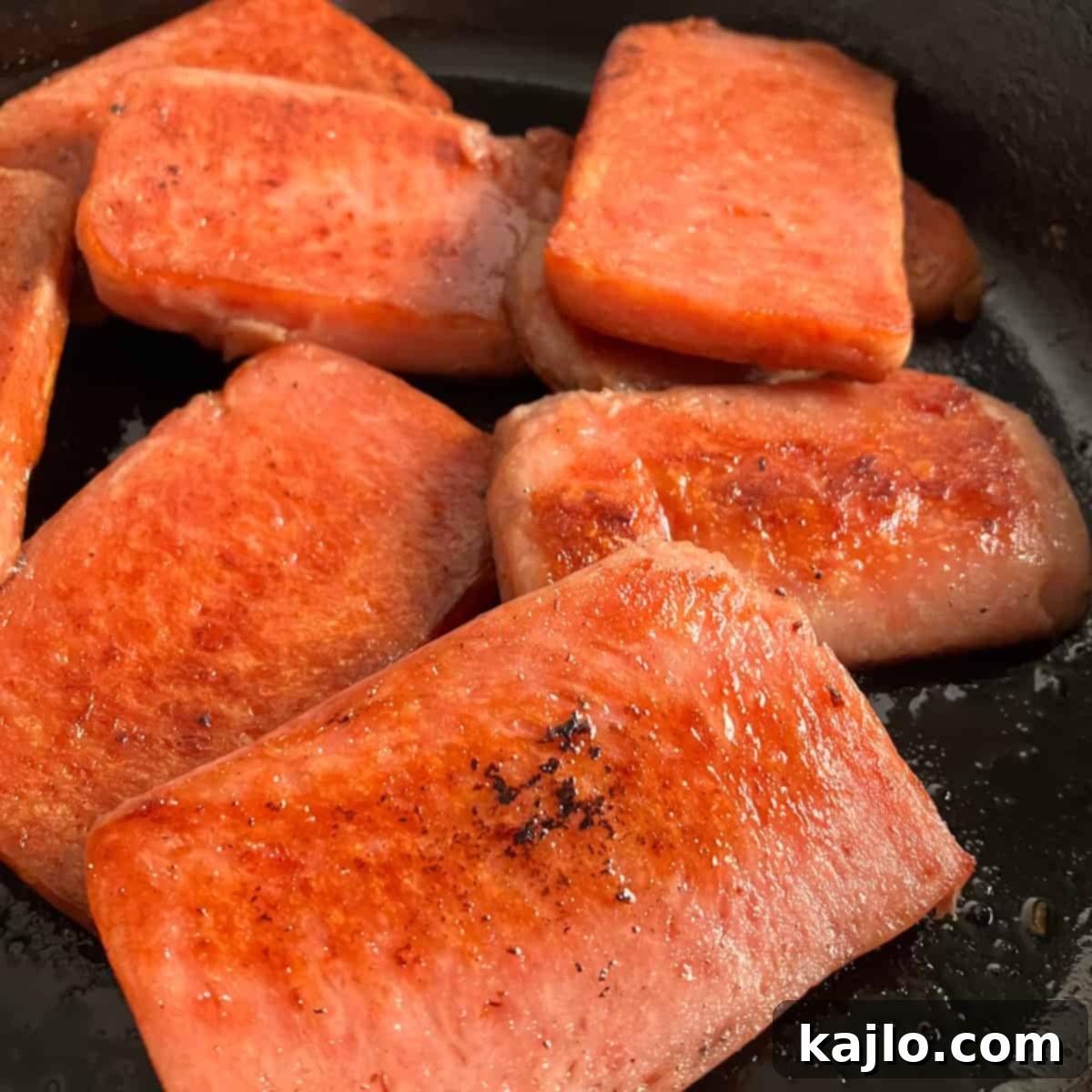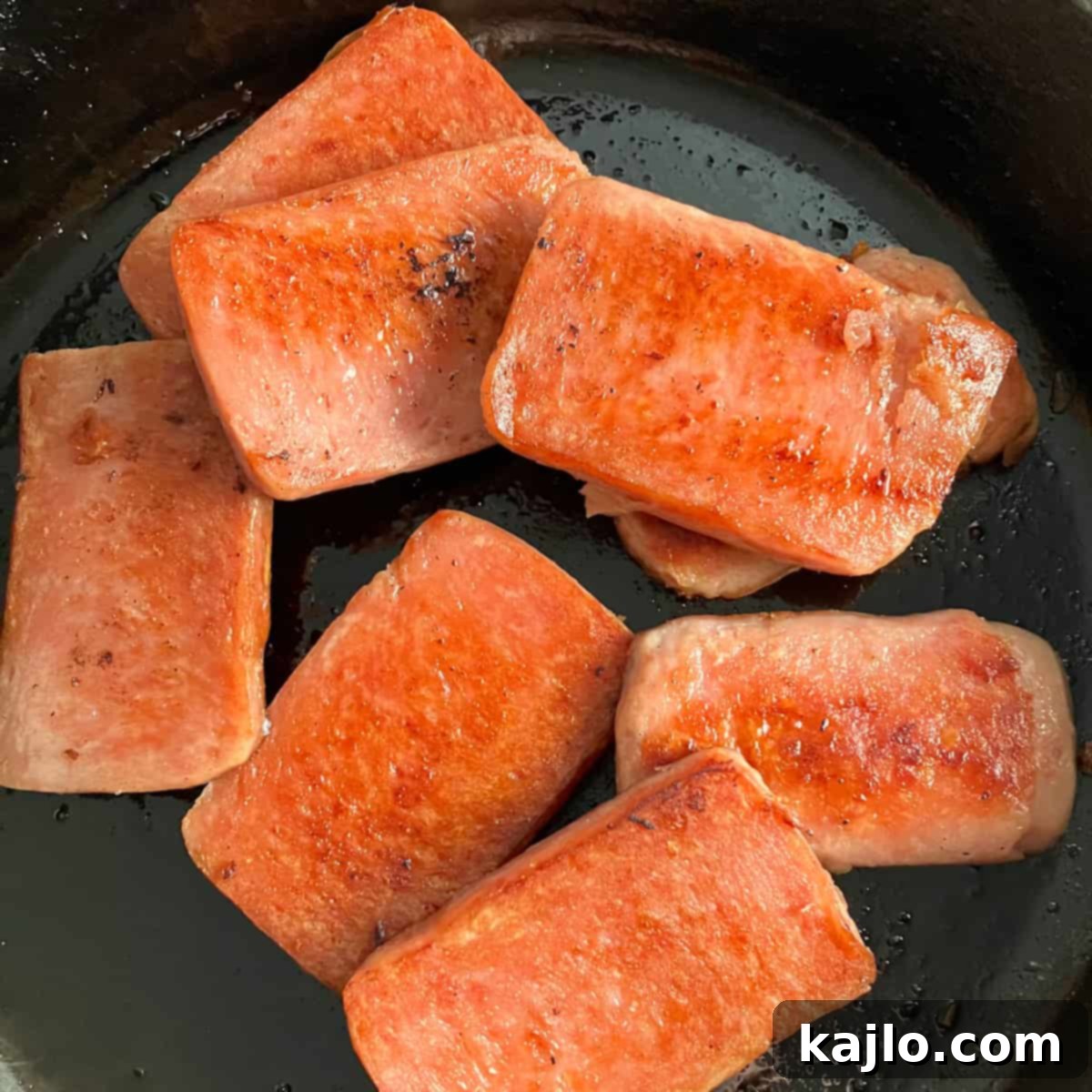Discover the ultimate guide on how to cook Spam to crispy perfection! This incredibly easy and satisfying pan-fried Spam recipe is widely regarded as the best way to cook Spam, transforming a simple canned staple into a delightful culinary experience. Cooking Spam is not only quick and straightforward but also results in a delicious, versatile protein that can elevate countless meals.
Once you master the art of perfectly crispy Spam, a world of culinary possibilities opens up. Utilize this savory meat for creative dishes such as savory Spam fries, a classic fried Spam sandwich, flavorful Spam fried rice, the iconic Spam musubi, or a hearty Spam and eggs breakfast. For many, cooked Spam evokes a sense of comforting nostalgia, deeply embedded in the breakfast traditions and culinary landscapes of Filipino and Hawaiian cuisine, where its popularity has remained steadfast for generations.
Whether you’re new to cooking Spam or looking to perfect your technique, this comprehensive guide will walk you through everything you need to know, from selecting the right variety to achieving that irresistible golden-brown crispness that makes it so beloved. Get ready to transform a humble can of Spam into a star ingredient that’s both economical and incredibly flavorful.

➕ What is Spam? Understanding the Iconic Canned Meat
SPAM is an internationally recognized, non-perishable, pre-seasoned pork product, conveniently packaged in a can and proudly manufactured by Hormel Foods (source). Its introduction to the market in 1937 marked the beginning of its journey to widespread popularity, particularly during challenging economic times like the Great Depression and in the post-World War II era.
The enduring appeal of Spam can largely be attributed to two significant advantages: its remarkably long shelf life and its affordability. These characteristics made it an invaluable and accessible source of protein, especially crucial for providing sustenance to military members overseas and in regions where fresh local meat was scarce or difficult to transport, such as the Hawaiian islands. Its robust nature ensured that it could withstand varied climates and logistical challenges, making it a reliable food source for many.
Beyond its practical benefits, Spam carved out a unique niche in global culinary traditions. Its distinctive taste and texture offered a different experience compared to other meats, contributing to its lasting legacy. Understanding these foundational aspects helps contextualize why Spam remains a beloved and often nostalgic food item for millions around the world, especially for those who grew up with it as a household staple.

What Does SPAM Stand For? Unveiling the Mystery
The true meaning behind the name “SPAM” has been a topic of speculation for decades, with Hormel Foods maintaining a veil of secrecy around its origins. According to an article on the Hormel Foods website, the actual meaning of SPAM is known only to a select group of former executives within the company. This deliberate mystery only adds to its legendary status.
What we do know is that the ingenious name was coined by Ken Daigneau, the brother of a former Hormel Vice President, during a naming contest. While the official meaning remains undisclosed, one of the most popular and widely circulated theories suggests that “SPAM” is an acronym for “SPiced HAm.” This theory makes sense given the product’s primary ingredients and its savory, pre-seasoned nature.
Interestingly, many cans of Spam today playfully offer a different interpretation, proclaiming SPAM means “Sizzle Pork And Mmm.” This witty phrase perfectly captures the appealing sizzle of pan-fried Spam and the delicious experience it offers, reinforcing its place in popular culture with a touch of humor. While the original meaning may remain a corporate secret, its various interpretations contribute to its unique brand identity.
Can You Eat Spam Uncooked? The Truth About Its Preparation
Technically, yes, Spam can be consumed straight from the can without any further cooking. Since it undergoes a canning process, it is considered fully cooked and safe to eat right away. However, the experience of eating Spam directly from the can is often described as less than ideal due to its somewhat mushy texture and the infamous gelatinous layer that surrounds the meat.
For most palates, the true magic of Spam is unlocked through cooking. Frying it until it achieves a delightful crispiness transforms its texture and flavor, making it significantly more appetizing. The heat renders some of its fat, creating a golden-brown crust and a more pleasant mouthfeel. Therefore, while it’s technically edible uncooked, you’ll likely find yourself wanting to crisp it up first to enjoy its full potential.
Given that Spam is pre-cooked and boasts an extended shelf life, it’s an excellent addition to any emergency food supply. It’s a reliable source of calories and protein that requires no refrigeration until opened, making it one of the best canned foods for emergency preparedness. Just remember, even in a pinch, a quick pan-fry can make a big difference in enjoyment!
Why Do Hawaiians Love Spam So Much? A Cultural Deep Dive
Spam holds an incredibly unique and prominent place within the food culture of Hawaii. It’s not merely a popular food item; it’s a culinary icon, reflected in the fact that Hawaiians have the highest per capita consumption of Spam in the entire world (source). This deep affection for Spam stems from its historical introduction and its seamless integration into local cuisine.
Spam first arrived in Hawaii during World War II, when it was served as a staple luncheon meat to American GIs stationed on the islands (source). Faced with limited access to fresh meat due to wartime logistics and the islands’ remote location, Spam proved to be an ideal solution: it was inexpensive, non-perishable, and packed with flavor. Its unique taste quickly resonated with the local population, and it became a beloved ingredient in many traditional Hawaiian dishes, laying the groundwork for its enduring popularity.
Beyond its wartime origins, Spam’s popularity in Hawaii persists for several compelling reasons. Firstly, its ease of shipping and long shelf life make it a practical and readily available protein source, especially compared to the logistical challenges of transporting fresh or frozen meats to the islands. Secondly, its distinctive savory flavor and satisfying texture are genuinely enjoyed by locals, who have masterfully incorporated it into a myriad of dishes, from the famous Spam Musubi to hearty breakfast plates.
Furthermore, Spam is incredibly versatile and economical, offering a tasty and affordable way to add meat to meals. While some might raise concerns about its nutritional profile, particularly its sodium and fat content, its cultural significance, delicious taste, and convenience ensure its continued prominence in Hawaiian households and restaurants. It represents a cherished part of Hawaiian heritage and comfort food, a testament to its ability to adapt and thrive in a unique culinary landscape.
🔥 Mastering Crispy Fried Spam: Your Go-To Guide
Get ready to create perfectly crispy, golden-brown Spam slices with these simple, step-by-step instructions on how to cook Spam on the stove. This method is incredibly fast, easy, and yields a delightfully savory result that’s far superior to eating it straight from the can.
Begin by carefully removing the Spam from its 12 oz (340 gram) can. For classic fried Spam, cut the entire loaf into 8 uniform slices, each approximately ⅓ to ½ inch thick. If you’re aiming for a fun alternative like Spam fries, you can cut each of these slices in half lengthwise, creating thinner, fry-like strips. Uniformity in thickness is key here for even cooking and consistent crispiness.
Place a well-seasoned cast iron pan or any heavy-bottomed skillet on your stovetop over medium heat. Allow the pan to preheat thoroughly for several minutes. A properly preheated pan is crucial for achieving that desirable crispy crust and preventing sticking. If you skip this vital preheating step, you’ll need to add an extra 1-2 minutes to the overall cooking time to ensure the Spam reaches optimal crispness. The sizzle when the Spam hits the pan is what we’re looking for!
How long do you cook Spam on each side for perfect crispiness? Once your pan is hot, arrange the Spam slices in a single layer, ensuring they don’t overlap. Cook each side for approximately 3-5 minutes. I typically aim for five minutes per side to achieve a deep golden-brown crust. For those who prefer their Spam extra crispy, you can extend the cooking time slightly, keeping a close eye on it to prevent burning. Remember that the slices positioned in the center of the pan often cook faster due to higher heat distribution; you may need to flip these earlier or move them to the cooler edges of the pan to ensure all slices cook evenly. The goal is a beautiful, caramelized exterior.

Can you fry Spam without oil? Absolutely! Spam is inherently high in fat, and as it heats, it begins to render its own oils, which are more than sufficient for frying. If you’re using a well-seasoned cast iron skillet or a good quality non-stick pan, you won’t need to add any additional cooking oil. Simply place the Spam slices directly onto the hot surface. If you notice any pieces starting to stick, gently move them around in the pan or add a very small amount of oil as a last resort. This self-rendering fat is key to achieving that signature crispiness without extra grease.
Once the Spam slices are cooked to your desired level of crispiness and have a beautiful golden-brown color on both sides, carefully remove them from the pan. Serve your freshly fried Spam immediately with your favorite dipping sauce or alongside a hearty breakfast spread. The exterior should be delightfully crunchy, while the inside remains tender and savory. Enjoy this simple yet incredibly satisfying dish!

As you can see, the directions for how to cook Spam are incredibly simple and bear a striking resemblance to frying bacon. This makes Spam a fun, flavorful, and economical alternative to your usual breakfast meats, offering a delicious twist on standard bacon or sausage. Its versatility ensures it can be enjoyed in a myriad of ways beyond just breakfast, making it a valuable addition to your culinary repertoire.
What is the Best Way to Fry Spam for Optimal Crispiness?
In my opinion, the absolute best way to make fried Spam slices is to use a properly preheated and well-seasoned cast iron skillet without any added oil. This method harnesses Spam’s natural fat content, allowing it to render down and create an incredibly crispy exterior without adding extra grease. It’s the easiest, most cost-effective approach, and cleanup is remarkably simple.
However, if you’re looking for an alternative that still delivers fantastic crispiness with minimal effort, making air fryer Spam is another excellent option. This method uses circulating hot air to achieve a similar crunch with slightly less hands-on cooking. Both techniques are superb for transforming Spam into a delectable, crispy treat, making it difficult to choose just one as the ultimate best.
Do You Need to Rinse Spam Before Cooking? Reducing Sodium Content
Generally, there is no culinary requirement to rinse or soak Spam before cooking. It comes pre-seasoned and ready to be sliced and fried. However, if your goal is to reduce the sodium content, rinsing or soaking Spam in water can be a viable option. Spam is known for being quite salty, so this method can help in managing your dietary sodium intake.
If you choose to rinse or soak your Spam, it’s crucial to thoroughly pat the Spam dry afterwards and remove as much excess water as possible before placing it in the pan. Any lingering moisture will prevent the Spam from crisping up properly, resulting in a less desirable, softer texture. An even simpler alternative for those monitoring sodium is to opt for Spam Lite, which contains 25% less sodium than the classic variety, offering a convenient way to enjoy Spam with a reduced salt profile without extra prep steps.
What Does Fried Spam Taste Like? A Flavor Comparison
“Is fried Spam good?” and “Does fried Spam taste like bacon?” are common questions for those new to this iconic canned meat. Fried Spam offers a distinctly savory, umami-rich flavor that is often described as meatier and heartier than traditional bacon. Its taste profile might be more closely compared to thick slices of fried Canadian bacon or even a rich, salty ham, but with its own unique character.
While taste is certainly subjective, many people, including my own family, find fried Spam to be incredibly delicious, especially when cooked until crispy. The frying process renders out some of its fat, concentrating its savory notes and creating a satisfying texture contrast between the crunchy exterior and tender interior. It’s a flavor that stands on its own, distinct from other breakfast meats.
If you’re specifically craving a bacon-like flavor with your Spam, you’re in luck! Hormel also offers canned Spam with Bacon. This specialized product is a blend of classic Spam and real bacon, enhanced with added bacon fat and preservatives to truly capture that smoky, porky essence you’re seeking. It’s an excellent choice for those who want the convenience of Spam with an undeniable bacon twist.
Can You Fry Spam with Oil? Tips for Cooking Different Varieties
Yes, you can certainly fry Spam with oil, but it’s often an unnecessary step if you’re using classic Spam and a properly seasoned cast iron skillet. Classic Spam is naturally high in fat, and it begins to render its own oils very quickly once it hits the hot pan, providing ample lubrication for frying and contributing to its crispiness. This self-rendering fat is usually enough to prevent sticking and achieve a golden-brown crust.
However, there’s an exception to this rule. If you’re using Spam Lite, which contains 50% less fat than the classic version, adding a small amount of oil to your skillet might be beneficial. The reduced fat content in Spam Lite means it may not produce enough of its own oil to fry evenly and achieve the desired crispness without a little assistance. A light coating of neutral cooking oil can ensure it browns beautifully and doesn’t stick.
Can You Fry Spam with Butter? Elevating Flavor
“Do you use butter to cook Spam?” is a question that often comes up for those looking to add another layer of flavor. While butter offers an undeniably rich and delicious flavor profile to pan-fried foods, it can also brown and burn quite easily, especially over medium to high heat. This is due to the milk solids present in regular butter, which have a lower smoke point.
If you’re eager to infuse your fried Spam with a buttery taste, I highly recommend using ghee, also known as clarified butter. Ghee has had its milk solids removed, giving it a significantly higher smoke point than regular butter. This makes it an excellent choice for frying, allowing you to achieve a beautiful crisp on your Spam without the risk of burning the butter. A tablespoon of ghee can add a fantastic depth of flavor and a lovely golden finish to your crispy Spam slices.
How to Oven Bake Spam for a Hands-Off Approach
For a less hands-on cooking method that still delivers delicious results, oven-baking Spam is a fantastic option. Begin by preheating your oven to 425 degrees Fahrenheit (218°C). While the oven preheats, slice your Spam loaf into your preferred thickness, typically 8 uniform slices from a standard can. Arrange the Spam slices in a single layer on a baking sheet, ensuring there’s no overlap for even cooking.
Bake the Spam for approximately 10 minutes, or until the slices are crisped to your liking and have developed a beautiful golden-brown color. Depending on your oven and desired level of crispness, you might need to adjust the baking time by a minute or two. This method is great for preparing larger batches or when you want to avoid standing over the stovetop, offering a convenient way to enjoy perfectly cooked Spam.
How to Store Spam Leftovers: Maximizing Freshness
Proper storage is key to enjoying your Spam for as long as possible after opening. Once a can of Spam has been opened, or if you have leftover cooked Spam, it must be promptly refrigerated to maintain freshness and safety. You can store leftover fried Spam or unused portions from an opened can in an airtight container in the refrigerator for up to 3-4 days. This ensures it remains palatable and safe for consumption.
For longer storage, Spam can also be frozen. To do this, place the leftover Spam slices or chunks into freezer bags, pressing out as much air as possible before sealing. Freezing Spam allows you to store it for extended periods, providing a convenient option for future meals. When you’re ready to use it, simply thaw it in the refrigerator overnight before reheating and enjoying.
️🍚 What Goes with Fried Spam? Delicious Serving Ideas
How is Spam supposed to be eaten? The beauty of fried Spam lies in its incredible versatility. A timeless and beloved combination for breakfast is the classic fried Spam and eggs. The salty, crispy Spam pairs wonderfully with the rich creaminess of eggs, whether scrambled, fried, or poached. For a fun, low-carb twist, I love serving crispy Spam with chaffles (cheese and egg waffles), a side of ketchup for dipping, and a refreshing medley of fresh berries to balance the richness.

Here are some other delightful side dishes and meal ideas that complement fried Spam perfectly, enhancing its savory flavor in various culinary contexts:
- Copycat Denny’s Pancakes: The sweet and fluffy pancakes offer a fantastic contrast to the salty Spam, creating a balanced and satisfying breakfast.
- Cooked Rice: A staple pairing, especially in Hawaiian and Asian cuisines. The simple neutrality of white rice perfectly absorbs Spam’s rich flavor, forming the base for many iconic dishes like Spam Musubi.
- Costco Muffins: For a quick and easy breakfast or brunch, a warm muffin provides a delightful texture and flavor contrast.
- Fried Egg in Air Fryer: Pair your crispy Spam with an effortlessly cooked fried egg, a classic combination made even easier with an air fryer.
- Tater Tots or Hash Browns: The crispy potato texture and mild flavor provide an excellent foundation for fried Spam.
- Fresh Pineapple or Mango: The sweetness and acidity of tropical fruits cut through the richness of Spam, creating a refreshing balance, a common pairing in Hawaiian cuisine.
Beyond breakfast, consider substituting bacon with Spam in an air fryer breakfast sandwich for a flavorful upgrade. You can also stir cubed Spam into your favorite mac and cheese for a hearty, savory twist, or add it to a quick stir-fry for an extra punch of umami. For a truly satisfying meal, transform your leftover rice into a delicious batch of Spam fried rice, incorporating vegetables and a hint of soy sauce for a complete dish. The possibilities are truly endless when you have perfectly cooked Spam on hand!
🧂 How to Season Fried Spam: Enhancing Its Flavor Profile
What should I season Spam with? Given that Spam comes robustly pre-seasoned and is inherently quite salty, you typically don’t need to add much, if any, additional seasoning like soy sauce or extra salt. Its flavor is bold and distinct right out of the can, especially once fried to a crispy texture. However, one of the easiest and most enjoyable ways to customize and enhance your fried Spam experience is by exploring the wide array of Spam flavor variations available.
Hormel Foods has innovated beyond the classic Spam, offering a variety of exciting flavors that cater to different palates and culinary applications. Each variation introduces a unique twist, allowing you to diversify your meals without much effort in additional seasoning.
Here are some popular types of Spam you can find, each offering a different flavor dimension to your fried Spam:
- Spam Classic: The original, iconic flavor that started it all – savory, salty, and perfect for frying.
- Spam Lite: A lighter version with 25% less sodium and 50% less fat, ideal for those watching their intake.
- Canned Spam Jalapeño: Infused with a spicy kick, perfect for adding heat to your dishes.
- Spam 25% Less Sodium: For a direct reduction in salt without altering the classic taste significantly.
- Spam with Real Hormel Bacon: A flavorful blend that combines the best of both worlds – Spam with smoky bacon goodness.
- Turkey Spam: A leaner alternative made with turkey, offering a different flavor and texture.
- Spam with Tocino Seasoning: Inspired by the Filipino sweet-cured pork breakfast meat, offering a unique sweet and savory profile.
- Spam Teriyaki Flavored: Infused with a classic sweet and tangy teriyaki glaze.
- Hickory Smoke Spam: For a deeper, smoky flavor that enhances its meaty notes.
- Spam Hot & Spicy: For those who love an extra fiery kick in their meals.
Another creative idea to season fried Spam is to make caramelized Spam with brown sugar. By gently cooking Spam slices with a sprinkle of brown sugar, you can achieve a delicious sweet-and-savory crust. Just be careful not to burn the sugar, and you’ll be rewarded with a delightful, sticky, and deeply flavorful caramelized Spam that’s perfect for sweet and savory dishes like Spam Musubi or even on its own. These variations and simple additions allow you to endlessly experiment with your cooked Spam.
️🌡️ Is Spam Already Cooked? Understanding its Ready-to-Eat Nature
Yes, Spam is indeed already cooked! The canning process that Spam undergoes fully cooks the pork product, making it technically ready to eat straight out of the can. This is a significant advantage, particularly in situations where cooking facilities are limited or for emergency preparedness.
However, while it’s safe to consume raw, the gelled texture of Spam directly from the can is often not the most appealing. In my humble opinion, the best way to enjoy Spam is to cook it. Frying it transforms its texture, creating a delightful contrast between a crispy, golden-brown exterior and a tender, savory interior. This cooking step isn’t about food safety but about vastly improving the sensory experience, making Spam truly enjoyable and irresistible.
🍖 What is Spam Made Of? Decoding the Ingredients
For over eight decades, the classic Spam recipe has remained remarkably consistent, a testament to its enduring appeal. The ingredients used in classic Spam are straightforward, creating its distinctive flavor and texture that millions have come to love.
Here are the six primary ingredients found in a can of classic Spam:
- Pork with Ham: This is the primary meat component, a blend that gives Spam its rich, savory base.
- Salt: A crucial seasoning that not only enhances flavor but also acts as a preservative.
- Water: Used to maintain moisture and consistency within the product.
- Modified Potato Starch: Acts as a binder and helps with the texture.
- Sugar: A small amount is added to balance the savory and salty notes, contributing to its unique taste.
- Sodium Nitrite: A common curing agent and preservative found in many processed meats, responsible for Spam’s pink color and helping to prevent bacterial growth.
It’s important to note that SPAM is categorized as a highly processed food, often referred to as an ultra-processed food, due to its manufacturing process and the inclusion of preservatives and added sugar. While it is high in saturated fat and sodium, it is also notable for being low in carbohydrates, making it a suitable option for those following a keto-friendly diet. Understanding these ingredients provides insight into Spam’s nutritional profile and its role in various dietary patterns.

📋 Why is Spam So Fattening? Understanding Its Caloric Density
Spam is often perceived as a “fattening” food primarily because of its high fat content, which is the macronutrient that provides the most calories per gram. While it’s a calorie-dense food, understanding its macronutrient breakdown helps clarify why.
A single serving of classic SPAM, which is typically 2 ounces or 56 grams, contains approximately:
- 180 calories
- 1 gram of carbohydrates
- 7 grams of protein
- 16 grams of fat
Breaking this down further, roughly 80% of the calories in SPAM come from fat, about 16% from protein, and a minimal 2% from carbohydrates. (Please note that these figures are rounded on the product label, which is why the percentages may not add up to exactly 100%.)
The high proportion of fat makes Spam calorically dense, meaning a small serving provides a significant amount of energy. While this can be a benefit in survival situations or for those needing to increase calorie intake, it also means that moderation is key for individuals managing their weight or following a heart-healthy diet. Its rich flavor and satisfying texture are directly linked to this fat content, contributing to both its appeal and its caloric density.
FAQs About Cooking and Enjoying Spam
Can You Air Fry Spam for an Extra Crispy Result?
Absolutely! Air frying is an excellent method for achieving delightfully crispy Spam with minimal effort and oil. To make Spam in an air fryer, simply cut the Spam loaf into your desired slices or sticks. Arrange them in a single layer in your air fryer basket or on the trays of an air fryer oven, making sure not to overcrowd them to allow for proper air circulation.
Air fry the Spam at 350°F (177°C) for approximately 10-15 minutes. The exact cooking time will depend on the thickness of your Spam slices and how crispy you prefer them. If you’re using an air fryer oven, position the Spam on the top rack for best results. Remember to flip the Spam slices halfway through the cooking time to ensure even browning and crispiness on all sides. This method results in a wonderfully crunchy exterior and a tender, savory interior, making it one of the best ways to cook Spam for a healthier alternative to deep frying.
How to Fry Spam in the Microwave: Is It Possible to Get Crispy?
Unfortunately, you cannot achieve truly crispy fried Spam or any other food in a microwave oven. Microwaves excel at heating foods quickly by exciting water molecules, making them ideal for steaming, reheating, and defrosting. However, they lack the ability to create the Maillard reaction, which is responsible for the browning and crisping that occurs during frying, baking, or air frying.
If you attempt to “fry” Spam in the microwave, it will heat up and become soft, but it will not develop the desirable crispy texture that pan-frying or air frying provides. For reheating already cooked Spam, the microwave is perfectly suitable; simply microwave the slices for 1-2 minutes on high until thoroughly warmed through. But for crispiness, you’ll need to turn to other cooking methods.
Is Spam Gluten-Free? What to Look for on the Label
For individuals following a gluten-free diet, the good news is that classic Spam is generally considered gluten-free. My current can of classic Spam explicitly states that it is gluten-free, which is excellent for those with celiac disease or gluten sensitivities.
However, it’s always prudent to double-check the product label of any Spam variety you purchase. While the classic formulation is typically gluten-free, the ingredients for highly processed foods can occasionally change, or different flavor variations might contain gluten-derived ingredients. For the most accurate and up-to-date information regarding allergens, always refer to the nutritional information and ingredient list on the specific product package you are considering.
How to Deep Fry Spam for Ultimate Indulgence
For a truly indulgent and extra-crispy result, deep-frying Spam is an option that delivers a golden-brown crust and a tender interior. To deep fry Spam, you’ll first need to prepare your oil. Heat a sufficient amount of neutral cooking oil (such as vegetable, canola, or peanut oil) in a deep pot or a deep fryer to 350°F (177°C). Use a cooking thermometer to accurately monitor the oil temperature, as maintaining the correct heat is crucial for proper frying.
Carefully place your sliced Spam into the hot oil, ensuring not to overcrowd the pot, which can lower the oil temperature and lead to soggy Spam. Fry the Spam for approximately 2-3 minutes, or until each side is beautifully golden brown and crispy. Once cooked, remove the Spam slices from the oil and place them on a wire rack lined with paper towels to drain any excess oil. This method results in an intensely crispy and flavorful Spam, perfect for those special occasions or when you’re craving an extra crunchy treat.
Is Spam Worse Than Hot Dogs? A Nutritional Comparison
When comparing the nutritional profiles of Spam and hot dogs, the answer isn’t always straightforward, as “hot dogs” encompass a wide range of products. There are many different types of hot dogs available, including those made from 100% beef, chicken, or turkey, and various formulations that can be lower in sodium or fat.
Generally speaking, classic Spam tends to be higher in saturated fat and sodium compared to some leaner or low-sodium hot dog varieties. However, a highly processed, full-fat hot dog might have a similar, or even worse, nutritional profile than Spam. To make an accurate comparison, it’s essential to check the nutrition labels of the specific products you are considering. Depending on the particular hot dog chosen, you can certainly find options that present a healthier choice than classic Spam, especially if you prioritize lower saturated fat and sodium content.
Is Spam Worse for You Than Ham? Decoding the Health Aspects
When evaluating whether Spam is “worse” for you than ham, it’s generally accepted that ham often presents a more favorable nutritional profile, especially if we’re talking about lean cuts of ham or a traditional ham roast.
Believe it or not, many cuts of ham tend to be lower in both saturated fat and calories compared to classic Spam. Ham, particularly whole roasted or deli ham, often has fewer ingredients and less processing than Spam. While ham can still be high in sodium, its fat content is typically lower. For general health information purposes, and particularly if you are monitoring your intake of saturated fats and calories, most varieties of ham would be considered a healthier choice than SPAM. As always, checking the specific nutrition labels of both products is the best way to make an informed decision for your dietary needs.
What is the Slimy Stuff in Spam? Understanding the Gelatinous Layer
When you open a can of SPAM, you might notice a jelly-like, somewhat slimy substance surrounding the meat. There’s no need for alarm, as this is simply a naturally occurring gelatin. This gelatin forms around the meat as it cools and sets during the canning process. It’s similar to the gelatin you might find when cooking meat stocks or cooling roasted meats; as collagen breaks down and cools, it forms this jelly-like consistency.
Gelled Spam, while visually unappealing to some, is perfectly safe to eat. Its texture is akin to aspic, a savory jelly commonly used in European cuisine. However, many people find the taste and texture of this gelatinous layer unpleasant, which is another reason why cooking Spam, especially frying it, is so popular. Frying melts away this gelatin, leaving you with just the crispy, savory meat.
👨🍳 Versatile Spam Recipes: Beyond the Fry Pan
Spam’s versatility extends far beyond just frying it for breakfast. Its savory flavor and unique texture make it a fantastic ingredient for a wide array of creative and easy recipes. Don’t be afraid to experiment with Spam in your kitchen; its rich history in various cuisines proves its adaptability.
Here are some other delicious and easy recipes to try with Spam, showcasing its potential in diverse dishes:
- Spam Musubi: A quintessential Hawaiian snack, featuring a slice of perfectly fried Spam placed atop a block of seasoned long-grain rice, all wrapped together with a strip of nori seaweed. It’s the ultimate grab-and-go delight.
- Luncheon Meat Fries: For a fun, dippable appetizer or side, these are essentially breaded and deep-fried Spam sticks. The breading adds an extra layer of crunch, making them incredibly addictive.
- Hawaiian Pineapple Fried Rice with Spam: A vibrant and flavorful dish that combines savory Spam with sweet pineapple, fragrant sesame oil, colorful vegetables like carrots and peas, and leftover rice for a complete tropical meal.
- Korean Spam Eggs and Rice: A comforting and simple meal, often involving fried Spam, a sunny-side-up egg, and rice, sometimes drizzled with a savory sauce. Find a great recipe here.
- Spam Ramen: Elevate instant ramen by adding slices of crispy fried Spam, along with a soft-boiled egg and fresh greens, for a quick and satisfying gourmet-at-home experience.
Do chefs use Spam? Absolutely! While sometimes seen as a humble ingredient, Spam has earned its place in professional kitchens and elevated culinary creations. Don’t assume it’s too “low brow” for your own kitchen; many innovative chefs are incorporating Spam into modern dishes, showcasing its versatility and unique flavor profile (check out this article discussing its resurgence). Spam continues to make a comeback in mainstream gastronomy while steadfastly remaining an integral and cherished part of the food culture in various regions of the world. It’s a testament to its enduring appeal and adaptability that it can be found in both humble home kitchens and upscale restaurants.
Watch How to Make It!

Fried Spam (Easy How to Cook Spam Recipe)
Summer Yule
Print Recipe
Pin Recipe
10
minutes
10
minutes
Breakfast
American, Hawaiian
6
180
kcal
Ingredients
-
1
can
Spam
(12 ounces or 340 grams) -
Dipping sauce
(optional)
Love this recipe?
Please leave a comment below 😊
Instructions
- Remove the Spam from the can, and cut into 8 uniform slices.
- Preheat a well-seasoned cast iron pan on the stovetop over medium heat. (No oil is typically needed if your pan is well-seasoned and the Spam’s fat will render.)
- Place the Spam slices in a single layer in the frying pan, and cook for 3-5 minutes on each side until golden brown and crispy. Adjust cooking time if you prefer them extra crisp. Rotate or flip slices in the center of the pan as they tend to cook faster.
- After cooking, remove from heat and serve the crispy Spam with your favorite dipping sauce or alongside a hearty breakfast. Enjoy!
Save this Recipe
Saved!
Equipment
-
Cast Iron Skillet -
Knife -
Spatula
Notes
💭 Expert Tips from Dietitian Summer Yule
This is a level 3 recipe (suitable for weight maintenance and active lifestyles).
Is fried Spam healthy? Is Spam a healthy meat? While delicious, it’s generally understood that Spam is not the most nutritionally robust choice for everyday consumption.
The primary considerations with Spam are its high sodium and saturated fat content. If you are aiming for a low sodium diet or following specific heart-healthy dietary guidelines, Spam may not be the optimal choice for your regular meals.
However, it’s important to remember that most foods can fit into a balanced diet, provided you don’t have a strict medical nutrition therapy that must be rigorously followed. Therefore, it is entirely possible to enjoy a small portion of Spam occasionally as part of an otherwise healthy eating pattern. (Of course, it’s also perfectly fine to skip the SPAM if you prefer to indulge in other dietary treats instead.)
Something notable that I discovered while researching this article is that SPAM now offers single-serve packs. These convenient portions can be purchased on Amazon
here
. This innovation is fantastic for individuals, couples, or small families who might not finish an entire can of SPAM within the recommended few days after opening, helping to reduce food waste.
Nutrition information provided is for one standard serving, which is 2 ounces according to the can. In my opinion, a more realistic serving size is often 3 ounces (or ¼ of the can). If you opt for ¼ of the can (equivalent to 2 slices), simply multiply the listed nutrition information by 1.5 to adjust for your portion.
nutrition info disclaimer
All recipes on this website may or may not be appropriate for you, depending on your medical needs and personal preferences. Consult with a registered dietitian or your physician if you need help determining the dietary pattern that may be best for you.
The nutrition information is an estimate provided as a courtesy. It will differ depending on the specific brands and ingredients that you use. Calorie information on food labels may be inaccurate, so please don’t sweat the numbers too much.
“To taste” means to your preferences, which may have to be visual to follow food safety rules. Please don’t eat undercooked food x
Nutrition
Calories:
180
kcal
Carbohydrates:
1
g
Protein:
7
g
Fat:
16
g
Saturated Fat:
6
g
Sodium:
770
mg
Added Sugar:
1
g
Iron:
2
% DV
best way to cook spam, cooked spam, cooking spam, crispy spam, fried spam, how to cook fried spam, how to cook spam, how to fry spam, pan fried spam
Shop our cookbook!
Easy Air Fryer Recipes for One
Burning your air fryer recipes?
Here’s how to fix it!
Join our thriving community!
Subscribe to receive all of the latest and greatest recipes directly in your inbox, and follow me on
Facebook,
Pinterest,
Instagram,
and
YouTube for daily inspiration and cooking tips!
